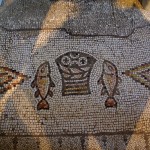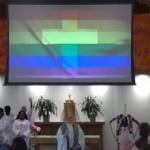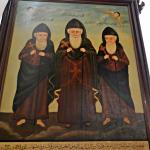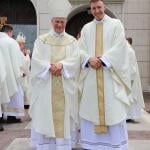Even your religion.
Max Lindenman describes his experience:
So great was my desperation that I felt no surprise, only relief, at finding the wit I sought on a right-wing discussion board, in the religion forum, and among the Catholics. Before Ted Haggard’s fall and Rick Warren’s rise, a certain section of American Bible Christianity was feeling its bloodiest and most thunderous. Members of the board’s fundamentalist contingent approached religious debate as they would a drunken game of Spades. Raise any objection in discussion and they’d slap down scripture verses like trump cards. Bam! How you like me now, sucka? For me, whose literary tastes ran to Philip Roth and Joe Queenan, it was a daunting sight.
The Catholics were less easily impressed. From their sleeves spilled quotes from Irenaeus, Ignatius of Antioch, and Justin Martyr, that their opponents could not but read and weep.
And they showed such panache. One Marquette grad (who, it must be noted, had drifted into gnosticism) capped off a link-heavy post too detailed for me to summarize by demanding, “Anyone want to quote John 3:16 to that?” He sounded like he was training an Uzi on a bank teller.
Impossible to miss, though, was the good humor with which Catholics regarded themselves and their faith. They treated the Gnostic not as a dangerous subversive, but as a slightly louche hero—their side’s own Jean Lafitte.
You’ll want to read it all
UPDATED: Speaking of another odd collision of religion and things-internetish, this fascinating article (hat tip to who else?) about a monk who learned calligraphy, eventually left the monastery to marry, and ended up teaching a calligraphy course to…Steve Jobs:
In 1968, he left the Trappists after 18 years to marry Catherine. He was dispensed from monastic vows and celibacy by Pope Paul VI. The couple had a son in 1970.
Robert Palladino obtained a position at Portland’s Reed College teaching calligraphy and ancient scripts.Among his students were science majors, including a young Steve Jobs, who later co-founded Apple Computers and credits the calligraphy course for the typefaces Mac computers have.
In 1987, after a long illness, Catherine died. Five years later, after hearing about the need for priests, the widower went to Portland’s archbishop, then-Archbishop William J. Levada, and offered his services.
The archbishop, now a cardinal and prefect of the Vatican’s doctrinal congregation, welcomed him. Three years later, with papal approval, Robert became a parish priest in 1995, serving for 12 years.
Kind of gives you a wonderful sense of God placing us where we’re meant to be at any particular moment, doesn’t it? Also really puts the kabosh on judging things and people. We none of us really understand how we are used for each other, or to what ends our gifts are enhanced or silenced.
What a wonder-ful world.












